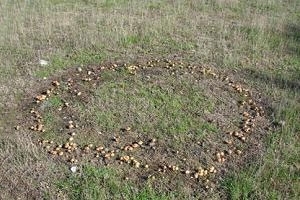Fairy ring champignon
 "He at once saw an unnumerable quantitie of very small people dancing rounde and rounde, singing and making all maner of small odd noyses."
"He at once saw an unnumerable quantitie of very small people dancing rounde and rounde, singing and making all maner of small odd noyses."
So wrote John Aubrey in 1633 of an encounter that his village curate had relayed to him, about coming across an “active” fairy ring one evening, just as the last light of day faded away. For hundreds of years it was believed that fairies, pixies or elves created these rings so that they could dance and sing around them and then sit for a rest on the small mushrooms to regain their breath. It was also strongly believed that it was alright to walk straight across a ring, but that you should never walk around the circle, as that was a special area conserved only for the fairies, and that an evil spell might be cast upon you should you do so.
Eventually people began to discredit the theory that fairies made these rings and instead believed that it was a lightning strike that produced the circle, as often it simply consisted of a dark green or brown ring, with no sign of any mushrooms. As late as 1953, experts were still writing with some authority that lightning was behind the sudden appearance of such circles.
We now know that slowly spreading colonies of the fungus marasmius oreades, often called scotch bonnet or the fairy ring champignon are responsible (although many other species of fungi can also produce rings). This fungus lives in the roots of grass, often altering the appearance of the sward and producing toadstools mainly in the late summer and autumn. The mycelium (underground threads of fungus) spreads gradually outwards, dying out in the centre, so that the colony is a roughly circular advancing ‘front’ of fungus growing through the soil.
The mycelium is relatively water repellent and so creates patches of brown, water-stressed dead grass which make an appearance in times of drought. As the dead grass decays it liberates nutrients, so that lush green circular patches can then occur. On other occasions, when conditions are favourable, toadstools occur also in a circular shape, creating the classic fairy ring.
The mycelium can spread at a rate of up to 30 cm (12 inches) a year and some of the enormous, round colonies of fungi which can be found, measuring many metres across, are believed to be centuries old. One of the largest rings ever discovered was in France and measured about 600 metres (2,000 ft) in diameter and is thought to be more than 700 years old!
I think that only Olympian fairies could manage to dance all the way around that particular ring non-stop, leaving many of the less fit stragglers to sit it out on a toadstool!
Peter Thompson
Advisory

Download Peter Thompson's essential 26-page book, featuring beautiful photography and detailed profiles of Britain's wildlife
Download FREE >